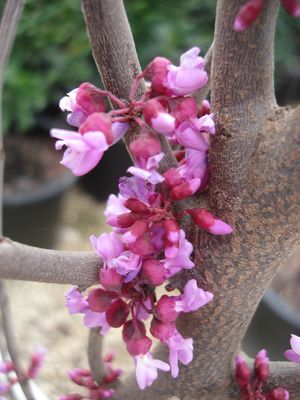Print This Page
Redbud, Mexican
Cercis reniformis 'Mexican'
Native to northern Mexico and parts of Texas, the Mexican Redbud (Cercis reniformis 'Mexican') is a hardy, drought-tolerant tree that thrives in arid and semi-arid landscapes. Smaller and more compact than the Eastern Redbud, it typically reaches 10–12 feet in height and width, making it ideal for urban settings or smaller gardens. In early spring, it produces vibrant magenta-pink flowers along its bare branches, creating a striking visual display that announces the arrival of warmer weather.
The Mexican Redbud stands out for its heart-shaped, wavy-edged leaves, which are thicker and more leathery than other Redbud varieties. These leaves have a glossy, waxy surface that reduces water loss, enhancing the tree's drought tolerance. In fall, the foliage turns a beautiful golden-yellow, adding seasonal interest to the landscape.
Once established, the Mexican Redbud is low-maintenance and resilient, thriving in a variety of soils, from clay to sandy, and tolerating both full sun and partial shade. It prefers neutral to slightly alkaline soils, making it well-suited for Texas landscapes. It has excellent resistance to pests and diseases, ensuring minimal upkeep. The Mexican Redbud is an outstanding choice for Texas gardens, providing both color and texture with its unique wavy leaves and vibrant spring blooms.
 |
Texas Native |
 |
Accent Tree |
 |
Low Maintenance |
Flower Color:Magenta Pink
|
 |
Height:10-12 Feet
|
 |
Spread:8-12 Feet
|
 |
|
USDA Hardiness Zone 5a
Available Sizes:
| Item |
Description |
| RBU-MEX-15 |
#015 REDBUD, MEXICAN |

|
Characteristics & Attributes
|
Deer Tolerance
|
Exposure
|
Habit
|
Soil pH Preference
|
|
Water Needs
|
Texas Native
|








